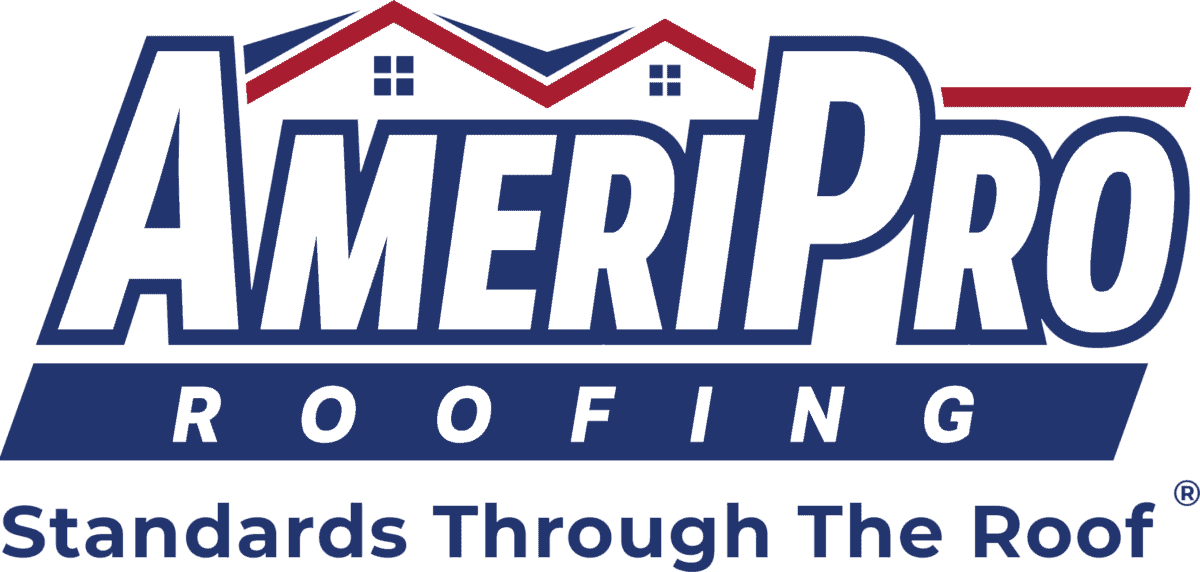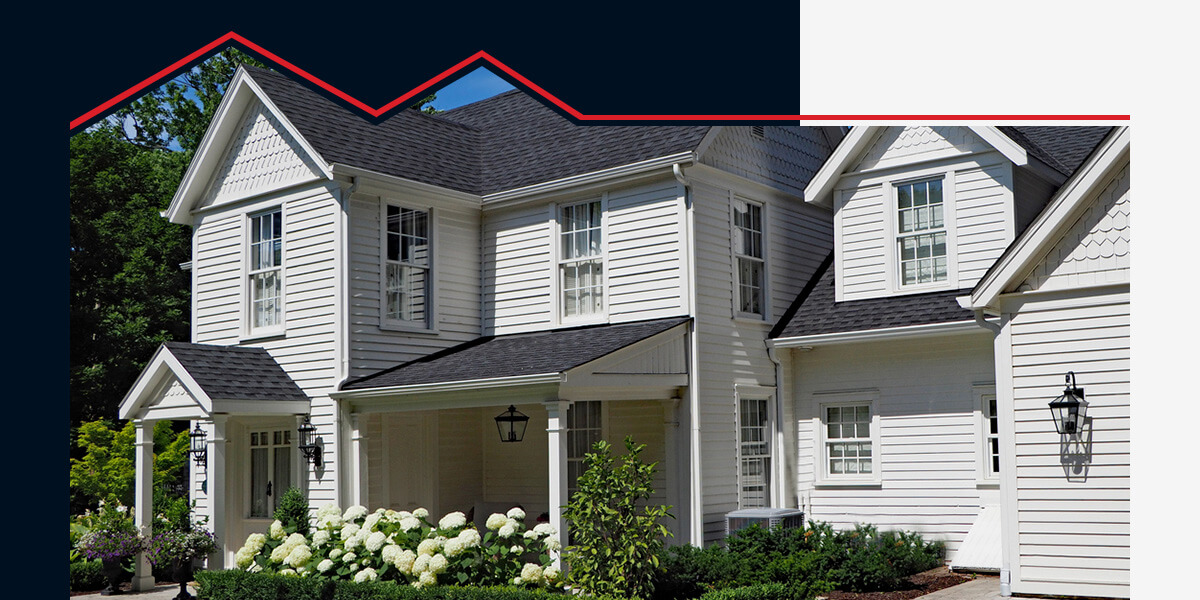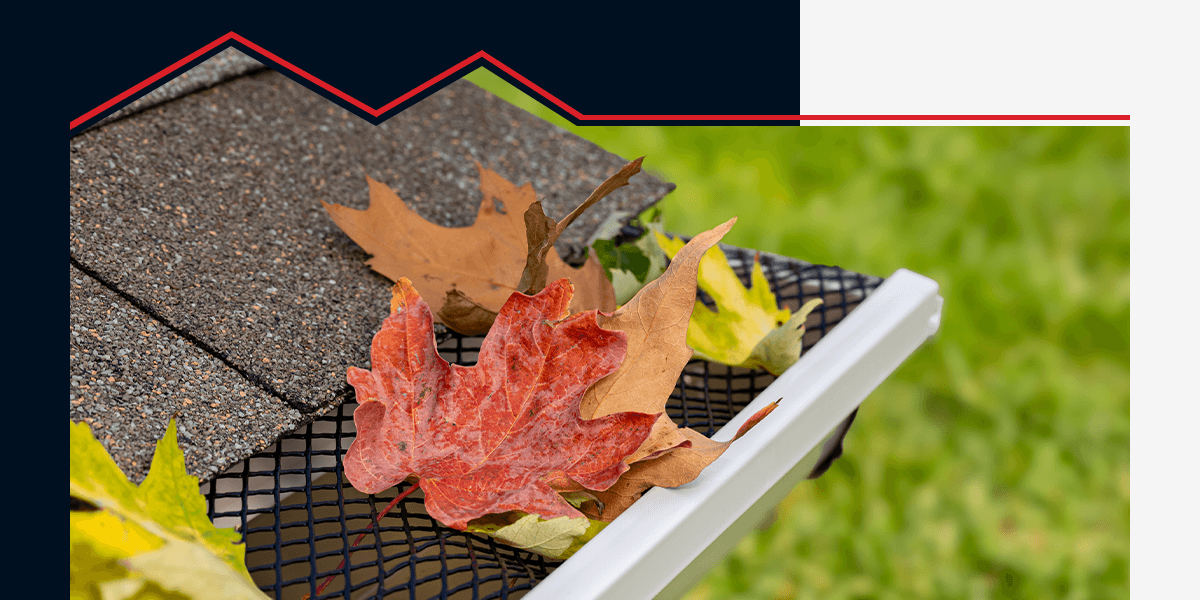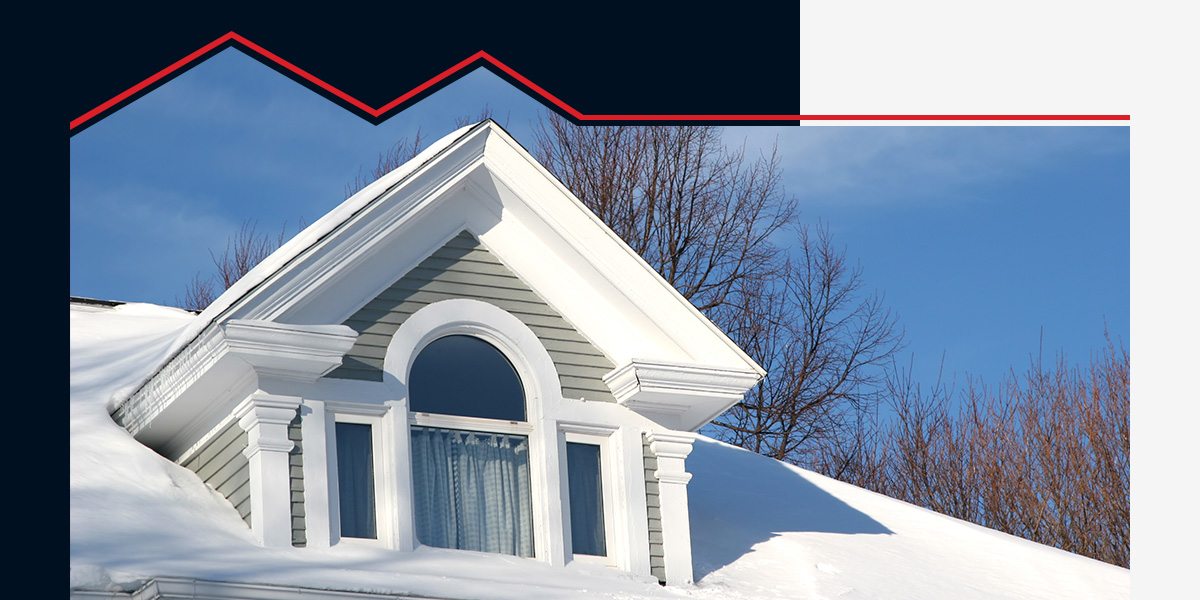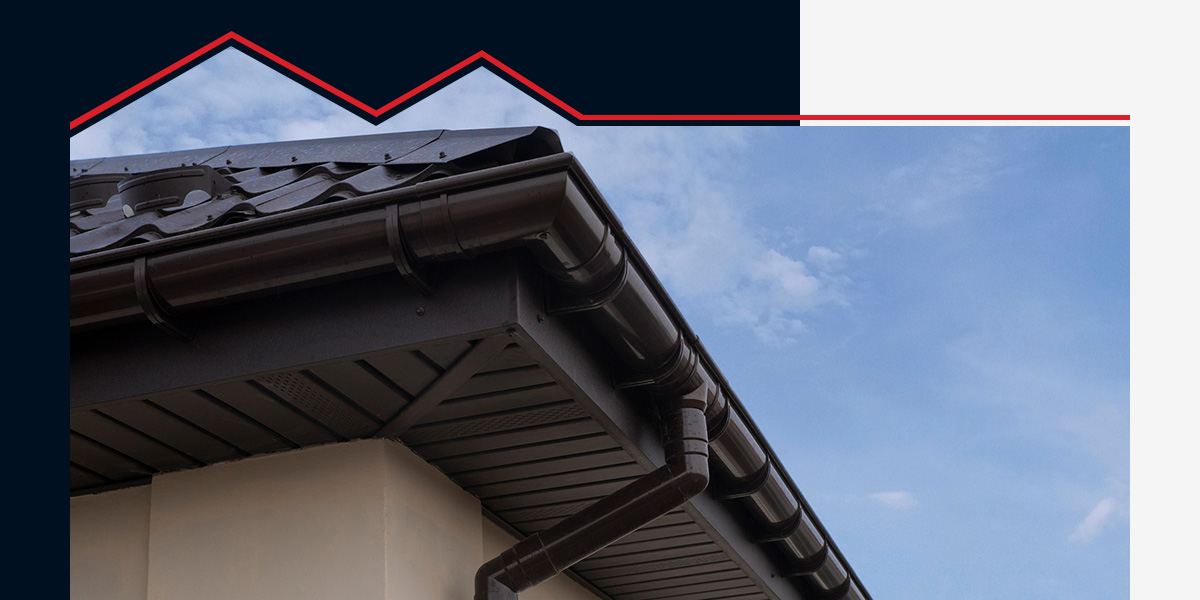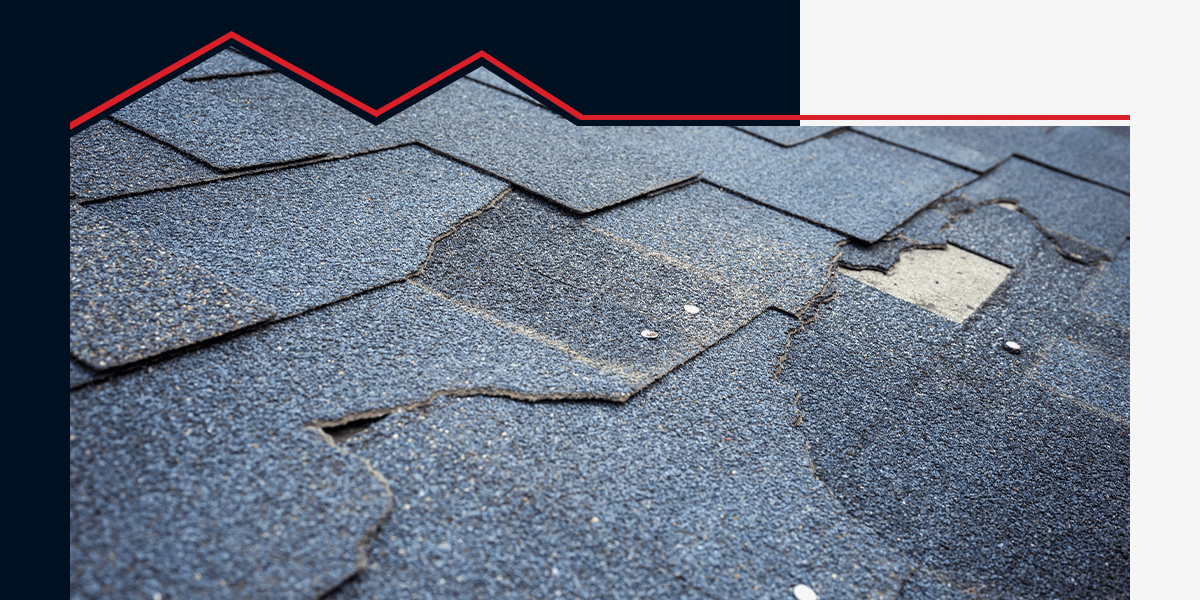
You may think that if a storm only produces wind, and not hail or rain, it won’t damage your roof. However, strong winds will create various stress points around your roof that can eventually compromise and weaken its structure. While roofs are designed to resist typical winds, they may still incur damage from more hazardous weather.
Fixing initial damage as soon as you notice loose or missing shingles is critical for ensuring the life of your roof. In the long run, preventative maintenance and roof repairs will save you additional costs on your utility bills.
How Does Your Roof Sustain Damage from Winds?
Wind damage to roofs starts at the edge and works inward, according to the National Roofing Contractors Association. When wind moves around your roof, it doesn’t move in a uniform pattern. Instead, areas like the perimeter and corners of the roof will get hit with much higher wind pressure. The roof’s center will have lower stresses in general, so it won’t end up experiencing as much damage.
Anywhere your shingles or other roofing material is loose at the edges, the wind will slip under it and push it upwards. Next time strong winds and storms come through, it’ll push loose roofing material up even more. Make sure you pay close attention to the corners and edges of your roof.
Harsh Winds Carry Debris
Exceedingly strong winds can pick up debris and cause them to hit your roof. Hurricanes and tornadoes can carry tree branches, shards of glass, nails, stones and other sharp and heavy objects that are usually more damaging than the wind itself. After strong winds sweep through, you’ll want to make a point to examine your roof very closely. Look for any objects that blew onto your roof and check for broken or missing roof components.
The National Weather Service states that high winds between 40 to 57 miles per hour can cause moderate property damage. Residents should also watch out for wind speeds greater than 58 miles per hour for damaging high winds.
What Does Wind Damage Look Like on a Roof?
When a roof sustains wind damage, it shows signs of peeling. Peeling damage starts out very small, but it’ll quickly become problematic if you don’t address it right away. As more areas of your roof peel back, it’ll work its way away from the edges and toward the center of the roof.
Once this happens, your roof’s insulation will gradually expose itself to rain, snow, and other elements. It’ll start to leak, and you’ll end up with water damage. You can avoid this type of extensive damage by using high-quality roofing materials. As the years go by, it’s best to do routine maintenance and repairs to keep your roof in good condition.
Signs of Extensive Wind Damage to Your Roof
If you find wind damage that covers more than 30% of your roof, this usually falls into extensive wind damage. At this point, it’s more cost-effective to replace the entire roof rather than repair part of it. On the other hand, if you have localized wind damage that affects less than 30% of your entire roof, it’s possible to fix it.
Extensive wind damage to roofing typically requires the replacement of the roof shingles, ventilation pipes, chimney, fencing, gutters and the roof flashing. It means replacing major components of your property’s roofing system.
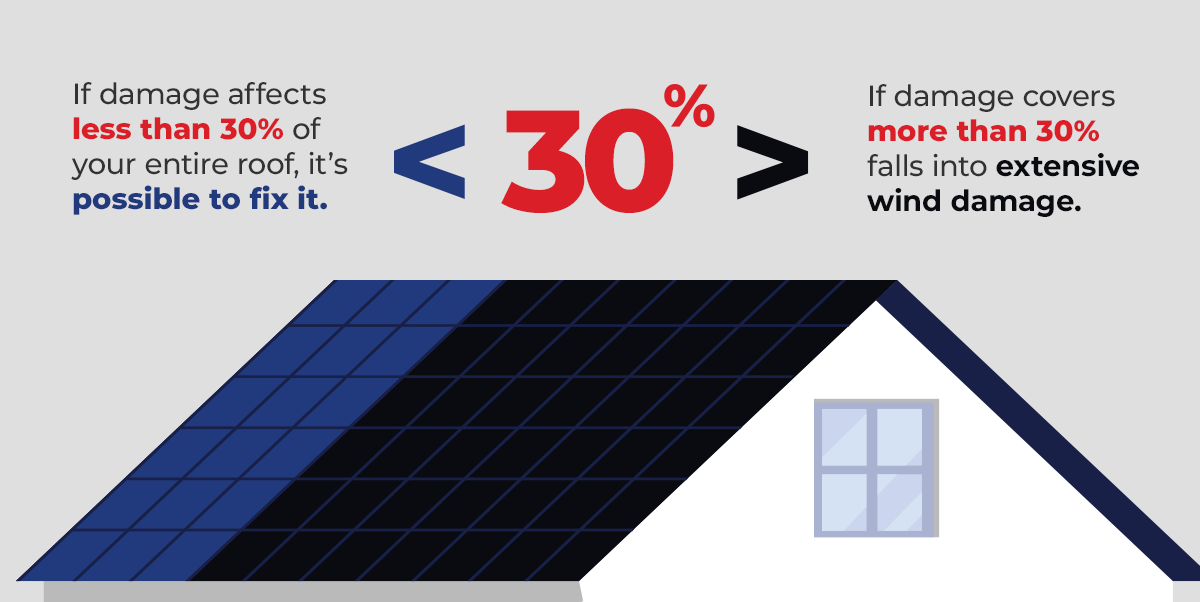
How to Check for Wind Damage on Your Roof
How do you know if your roof is damaged after any wind or weather event? The first thing you’ll want to do is take a quick look. You’ll be able to spot any stray debris lying on your roof that shouldn’t be there. Once you see and remove any stray debris, you’re ready to perform your inspection.
If you think your roof needs to be fixed, there are a few basic things you should check first. Be sure to inspect the following components for wind damage to your roof.
1. Composition Shingles
Shingles are one of the first and easiest roofing components to identify. They cover your roof and are made of different materials like asphalt, clay, wood, metal or slate. Shingles protect your roof and shed water from your property.
How do you spot wind-damaged shingles? You want to look for any missing shingles, signs of lifting and overlapping. Shingles can tear, crack, curl or be partially ripped away. Falling branches and other debris can puncture or rip shingles right off your roof and damage the material below them as well. Damaged composition shingles lose granulation, curl at the edges and are broken at some point across the shingle. Wooden shingles can curl, split, decay and mold with repeated damage.
2. Roofing Cement
If you’ve had previous holes or areas in your roof that you patched, you most likely used roofing cement to seal it off — double-check the roofing cement for any damage. You could see excess cement, cracks or the cement could start to crumble around the edges.
Roofing cement is a water-resistant material that’s typically used for sealing around vents and chimneys. It’s often used to repair holes or cover up uneven valleys on a roof. After a strong storm, it’s worth checking if your roofing cement still holds.
3. Chimney
Damage to the chimney can result in missing or loose flashing, cracked joints and cracked or missing bricks. After a windy storm, check for crumbling and eroded mortar around your chimney. Mortar holds up a chimney’s structure and keeps bricks molded together. If you find a lot of crumbled mortar, your chimney might need timely repairs.
The chimney is a structure that can lean away by itself, and this can cause the flashing to tear away as the house settles independently. A chimney can lean when your property’s ground erodes or compacts, making its foundation settle unevenly.
4. Flashing
Flashing is the small metal pieces at the joints of your roof that work to form a watertight seal. You’ll find it around the base of your chimney, around skylights or in any area where the roof forms a joint.
Look for buckled areas around your roof and penetrations or tears in the flashing. Damaged flashing can also have dents or look warped. As flashing wears down due to harsh weather, it can bend and develop rust, and could indicate leaks waiting to happen.
5. Fascia and Soffits
The fascia and soffits work to seal in the edges of your roof and protect the interior from the elements. Since they’re on the edge, they’re prone to taking a lot of damage. Check the soffit and ridge vents for clogs. The shingles and flashing could be missing or curled up if they sustain damage.
Roof fascias are usually made of wood or plastic to protect your roof from rain. For fascia made of wood, cracking paint is usually a sign of damage. When paint cracks, moisture can seep through and cause the fascia to rot. Look for stained areas that indicate water is slipping in, and you may also see signs of decay.
6. Downspouts and Gutters
Your downspouts and gutters can develop leaky seams, rust spots, bend, hang down and lose their attachment to the roof. They may also clog with debris, and you may find that you have missing sections from the downspout or gutter itself. If your gutter clogs, it can freeze and cause weight to put stress on the fastener. This can pull the gutter from the house.
Any debris, from leaves to larger pieces of wood, can easily clog your gutters and cause them to overflow. Tree branches that touch the roof can easily cause gouges or scratches when the wind blows them. Make sure to keep nearby trees trimmed and dispose of tree branches properly.
7. Flat Roof
Unless you get up on the roof, it can be slightly more difficult to tell when your flat roof has damage. Cracks and tears or obvious missing patches are common. Wrinkles and blisters are two more things to look for. If you have patched areas and can get into your attic, check for water leaks or damp areas in your interior roof.
Houses with flat roofs are generally more susceptible to wind and weather damage than gabled or pitched roofs. Unlike gabled roofs that easily shed water, their flat design is not made to withstand heavy rainfall. This may cause water to pool and leak into your home. If you have a flat roof, it’s best to check it for damage thoroughly.
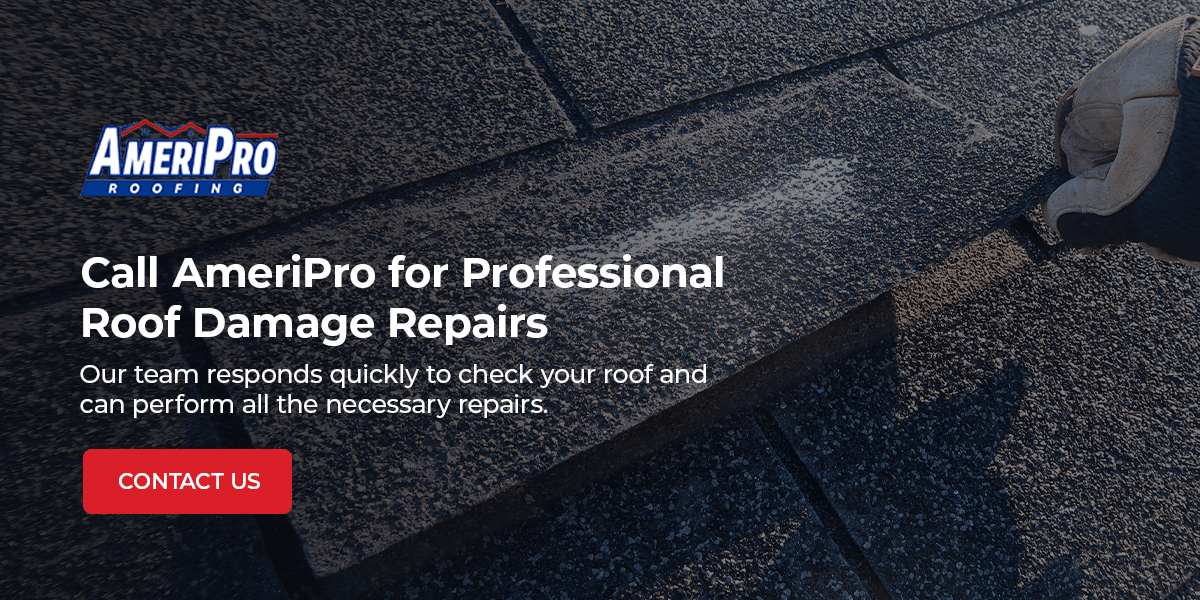
Do an Indoor Inspection
Once you do a thorough outdoor inspection of your roof, it’s time to do an indoor inspection. You’ll start by looking for moisture marks on your ceiling and walls. Moisture marks can be brown, grey, or yellow stains. The paint could peel away from the wall or ceiling. Check your attic for any leaks or dampness along the rafters. If you notice your energy costs suddenly spike for no reason, this could tell you that something happened to your roof ventilation system.
Call AmeriPro for Professional Roof Damage Repairs
If you find wind damage to your roof, get an experienced professional to handle it. At AmeriPro Roofing, we only use high-quality materials to help restore your wind-damaged roof.
Our team responds quickly to check your roof and can perform all the necessary repairs. Trust our experienced roofing professionals to deliver quality work with every job. We’ve successfully completed over 150,000 roofing projects for satisfied homeowners nationwide.
Contact us to schedule your residential roofing inspection today.


